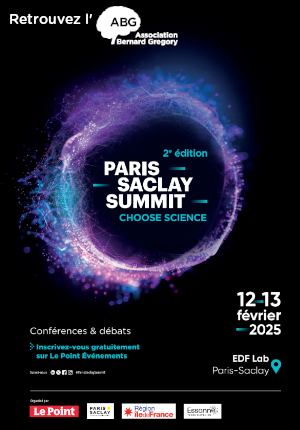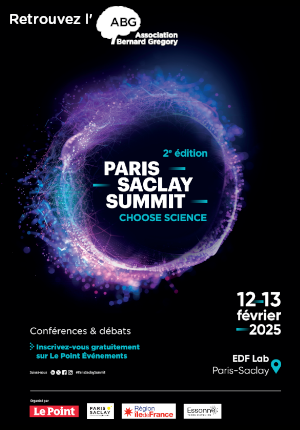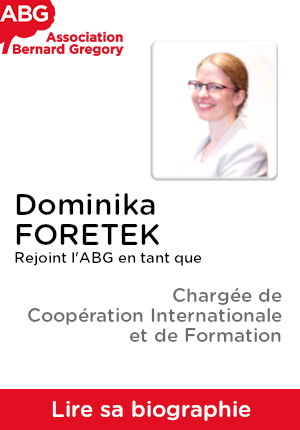Caliste-3D CZT: développement d'une nouvelle génération de spectro-imageur gamma pour répondre au défi de sensibilité des télescopes d'astronomie spatiale dans la bande du MeV. // Caliste-3D CZT: development of a new generation of gamma-ray imaging spectr
|
ABG-128325
ADUM-59204 |
Sujet de Thèse | |
| 04/02/2025 | Contrat doctoral |
Université Paris-Saclay GS Physique
Gif sur yvette - France
Caliste-3D CZT: développement d'une nouvelle génération de spectro-imageur gamma pour répondre au défi de sensibilité des télescopes d'astronomie spatiale dans la bande du MeV. // Caliste-3D CZT: development of a new generation of gamma-ray imaging spectr
- Terre, univers, espace
Semi-conducteur, Instrumentation, gamma, CZT
Semiconductor, Instrumentation, gamma, CZT
Semiconductor, Instrumentation, gamma, CZT
Description du sujet
L'observation multi-longueur d'onde des sources astrophysiques est la clé d'une compréhension globale des processus physiques en jeu. En raison de contraintes instrumentales, la bande spectrale de 0,1 à 1 MeV est celle qui souffre le plus d'une sensibilité insuffisante de détection dans les observatoires existants. Ce domaine permet d'observer les noyaux actifs de galaxies les plus enfouis et les plus lointains pour mieux comprendre la formation et l'évolution des galaxies à des échelles cosmologiques. Il révèle des processus de nucléosynthèse des éléments lourds de notre Univers et l'origine des rayons cosmiques omniprésents dans l'Univers. La difficulté intrinsèque de la détection dans ce domaine spectral réside dans l'absorption de ces photons très énergétiques après des interactions multiples dans le matériau. Cela requiert une bonne efficacité de détection mais également une bonne localisation de toutes les interactions pour en déduire la direction et l'énergie du photon incident. Ces enjeux de détection sont identiques pour d'autres applications à fort impact sociétal et environnemental : le démantèlement et l'assainissement des installations nucléaires, le suivi de la qualité de l'air, la dosimétrie en radiothérapie.
Cette thèse d'instrumentation a pour objectif de développer un détecteur « 3D » polyvalent, exploitable dans les domaines de l'astrophysique et de la physique nucléaire, avec une meilleure efficacité de détection dans la gamme 100 keV à 1 MeV et des évènements Compton, ainsi que la possibilité de localiser les interactions dans le détecteur à mieux que la taille d'un pixel.
Plusieurs groupes dans le monde, dont le nôtre, ont développé des spectro-imageurs X dur à base de semi-conducteurs denses et pixélisés pour l'astrophysique (CZT dans la mission NuSTAR, CdTe dans les missions Solar Orbiter et Hitomi), pour les synchrotrons (Hexitec UK, RAL) ou pour des applications industrielles (Timepix, ADVACAM). Leur gamme d'énergie reste toutefois limitée à environ 200 keV (sauf pour Timepix) en raison de la faible épaisseur des cristaux et de leurs limitations intrinsèques d'exploitation. Pour repousser la gamme en énergie au-delà du MeV, il faut des cristaux plus épais associés à des bonnes propriétés de transport des porteurs de charge. Les avancées dans la fabrication des cristaux CZT homogènes épais depuis plus de 20 ans nous permettent aujourd'hui d'envisager des détecteurs jusqu'à au moins 10 mm d'épaisseur (Redlen, Kromek). Il reste cependant plusieurs défis dans la mise en œuvre de ces cristaux et l'optimisation de leurs performances.
Le principal défi technique est l'estimation précise de la charge générée par interaction d'un photon dans le semi-conducteur. Dans un détecteur pixélisé où seules les coordonnées X et Y de l'interaction sont enregistrées, augmenter l'épaisseur du cristal dégrade les performances spectrales. Obtenir l'information de profondeur d'interaction Z dans un cristal monolithique permet théoriquement de lever le verrou associé. Cela nécessite le déploiement de méthodes expérimentales, de simulations physiques, de conception de circuits de microélectronique de lecture et de méthodes d'analyse de données originales. De plus, la capacité à localiser les interactions dans le détecteur à mieux que la taille d'un pixel contribue à résoudre ce défi et elle devient indispensable dans le cas d'interactions multiples par effet Compton.
------------------------------------------------------------------------------------------------------------------------------------------------------------------------
------------------------------------------------------------------------------------------------------------------------------------------------------------------------
Multi-wavelength observation of astrophysical sources is the key to a global understanding of the physical processes at play. Due to instrumental constraints, the spectral band from 0.1 to 1 MeV is the one that suffers most from insufficient detection sensitivity in existing observatories. This band allows us to observe the deepest and most distant active galactic nuclei, to better understand the formation and evolution of galaxies on cosmological scales. It reveals the processes of nucleosynthesis of the heavy elements in our Universe and the origin of the cosmic rays that are omnipresent in the Universe. The intrinsic difficulty of detection in this spectral range lies in the absorption of these very energetic photons after multiple interactions in the material. This requires good detection efficiency, but also good localisation of all the interactions in order to deduce the direction and energy of the incident photon. These detection challenges are the same for other applications with a strong societal and environmental impact, such as the decommissioning and clean-up of nuclear facilities, air quality monitoring and radiotherapy dosimetry.
The aim of this instrumentation thesis is to develop a versatile ‘3D' detector that can be used in the fields of astrophysics and nuclear physics, with improved detection efficiency in the 100 keV to 1 MeV range and Compton events, as well as the possibility of locating interactions in the detector at better than pixel size.
Several groups around the world, including our own, have developed hard X-ray imaging spectroscopes based on dense, pixelated semiconductors for astrophysics (CZT in the NuSTAR mission, CdTe in the Solar Orbiter and Hitomi missions), for synchrotrons (Hexitec UK, RAL) or for industrial applications (Timepix, ADVACAM). However, their energy range remains limited to around 200 keV (except for Timepix) due to the thinness of the crystals and their intrinsic operating limitations. To extend the energy range beyond MeV, thicker crystals with good charge carrier transport properties are needed. Advances in the manufacture of thick homogeneous CZT crystals over the past 20 years mean that detectors up to at least 10 mm thick are now possible (Redlen, Kromek). However, there are still a number of challenges involved in using these crystals and optimising their performance.
The main technical challenge is accurately estimating the charge generated by the interaction of a photon in the semiconductor. In a pixelated detector where only the X and Y coordinates of the interaction are recorded, increasing the thickness of the crystal degrades spectral performance. Obtaining Z interaction depth information in a monolithic crystal theoretically makes it possible to remove the associated challenge. This requires the deployment of experimental methods, physical simulations, the design of readout microelectronics circuits and original data analysis methods. In addition, the ability to localise interactions in the detector to better than the size of a pixel contributes to solving this challenge and becomes essential in the case of multiple interactions by the Compton effect.
------------------------------------------------------------------------------------------------------------------------------------------------------------------------
------------------------------------------------------------------------------------------------------------------------------------------------------------------------
Début de la thèse : 01/10/2025
Cette thèse d'instrumentation a pour objectif de développer un détecteur « 3D » polyvalent, exploitable dans les domaines de l'astrophysique et de la physique nucléaire, avec une meilleure efficacité de détection dans la gamme 100 keV à 1 MeV et des évènements Compton, ainsi que la possibilité de localiser les interactions dans le détecteur à mieux que la taille d'un pixel.
Plusieurs groupes dans le monde, dont le nôtre, ont développé des spectro-imageurs X dur à base de semi-conducteurs denses et pixélisés pour l'astrophysique (CZT dans la mission NuSTAR, CdTe dans les missions Solar Orbiter et Hitomi), pour les synchrotrons (Hexitec UK, RAL) ou pour des applications industrielles (Timepix, ADVACAM). Leur gamme d'énergie reste toutefois limitée à environ 200 keV (sauf pour Timepix) en raison de la faible épaisseur des cristaux et de leurs limitations intrinsèques d'exploitation. Pour repousser la gamme en énergie au-delà du MeV, il faut des cristaux plus épais associés à des bonnes propriétés de transport des porteurs de charge. Les avancées dans la fabrication des cristaux CZT homogènes épais depuis plus de 20 ans nous permettent aujourd'hui d'envisager des détecteurs jusqu'à au moins 10 mm d'épaisseur (Redlen, Kromek). Il reste cependant plusieurs défis dans la mise en œuvre de ces cristaux et l'optimisation de leurs performances.
Le principal défi technique est l'estimation précise de la charge générée par interaction d'un photon dans le semi-conducteur. Dans un détecteur pixélisé où seules les coordonnées X et Y de l'interaction sont enregistrées, augmenter l'épaisseur du cristal dégrade les performances spectrales. Obtenir l'information de profondeur d'interaction Z dans un cristal monolithique permet théoriquement de lever le verrou associé. Cela nécessite le déploiement de méthodes expérimentales, de simulations physiques, de conception de circuits de microélectronique de lecture et de méthodes d'analyse de données originales. De plus, la capacité à localiser les interactions dans le détecteur à mieux que la taille d'un pixel contribue à résoudre ce défi et elle devient indispensable dans le cas d'interactions multiples par effet Compton.
------------------------------------------------------------------------------------------------------------------------------------------------------------------------
------------------------------------------------------------------------------------------------------------------------------------------------------------------------
Multi-wavelength observation of astrophysical sources is the key to a global understanding of the physical processes at play. Due to instrumental constraints, the spectral band from 0.1 to 1 MeV is the one that suffers most from insufficient detection sensitivity in existing observatories. This band allows us to observe the deepest and most distant active galactic nuclei, to better understand the formation and evolution of galaxies on cosmological scales. It reveals the processes of nucleosynthesis of the heavy elements in our Universe and the origin of the cosmic rays that are omnipresent in the Universe. The intrinsic difficulty of detection in this spectral range lies in the absorption of these very energetic photons after multiple interactions in the material. This requires good detection efficiency, but also good localisation of all the interactions in order to deduce the direction and energy of the incident photon. These detection challenges are the same for other applications with a strong societal and environmental impact, such as the decommissioning and clean-up of nuclear facilities, air quality monitoring and radiotherapy dosimetry.
The aim of this instrumentation thesis is to develop a versatile ‘3D' detector that can be used in the fields of astrophysics and nuclear physics, with improved detection efficiency in the 100 keV to 1 MeV range and Compton events, as well as the possibility of locating interactions in the detector at better than pixel size.
Several groups around the world, including our own, have developed hard X-ray imaging spectroscopes based on dense, pixelated semiconductors for astrophysics (CZT in the NuSTAR mission, CdTe in the Solar Orbiter and Hitomi missions), for synchrotrons (Hexitec UK, RAL) or for industrial applications (Timepix, ADVACAM). However, their energy range remains limited to around 200 keV (except for Timepix) due to the thinness of the crystals and their intrinsic operating limitations. To extend the energy range beyond MeV, thicker crystals with good charge carrier transport properties are needed. Advances in the manufacture of thick homogeneous CZT crystals over the past 20 years mean that detectors up to at least 10 mm thick are now possible (Redlen, Kromek). However, there are still a number of challenges involved in using these crystals and optimising their performance.
The main technical challenge is accurately estimating the charge generated by the interaction of a photon in the semiconductor. In a pixelated detector where only the X and Y coordinates of the interaction are recorded, increasing the thickness of the crystal degrades spectral performance. Obtaining Z interaction depth information in a monolithic crystal theoretically makes it possible to remove the associated challenge. This requires the deployment of experimental methods, physical simulations, the design of readout microelectronics circuits and original data analysis methods. In addition, the ability to localise interactions in the detector to better than the size of a pixel contributes to solving this challenge and becomes essential in the case of multiple interactions by the Compton effect.
------------------------------------------------------------------------------------------------------------------------------------------------------------------------
------------------------------------------------------------------------------------------------------------------------------------------------------------------------
Début de la thèse : 01/10/2025
Nature du financement
Contrat doctoral
Précisions sur le financement
Concours d'accès aux contrats doctoraux*Autre type de financement -
Présentation établissement et labo d'accueil
Université Paris-Saclay GS Physique
Etablissement délivrant le doctorat
Université Paris-Saclay GS Physique
Ecole doctorale
127 Astronomie et Astrophysique d'Ile de France
Profil du candidat
Master ou diplôme d'ingénieur portant sur une ou plusieurs des thématiques suivantes : électronique analogique, électronique numérique, photonique, optique, physique des détecteurs, mesures physiques, traitement du signal. Des compétences relationnelles, rédactionnelles et de communication en anglais seront des atouts. Il lui faudra également un vif goût pour la réalisation expérimentale et pour le travail de groupe, ainsi que pour la programmation (Python, C++).
Master's degree or engineering diploma in one or more of the following areas: analogue electronics, digital electronics, photonics, optics, detector physics, physical measurements, signal processing. Interpersonal, writing and communication skills in English will be an asset. Interest in experimental work and group work, as well as programming (Python, C++).
Master's degree or engineering diploma in one or more of the following areas: analogue electronics, digital electronics, photonics, optics, detector physics, physical measurements, signal processing. Interpersonal, writing and communication skills in English will be an asset. Interest in experimental work and group work, as well as programming (Python, C++).
30/09/2025
Postuler
Fermer
Vous avez déjà un compte ?
Nouvel utilisateur ?
Besoin d'informations sur l'ABG ?
Vous souhaitez recevoir nos infolettres ?
Découvrez nos adhérents
 TotalEnergies
TotalEnergies  Institut de Radioprotection et de Sureté Nucléaire - IRSN - Siège
Institut de Radioprotection et de Sureté Nucléaire - IRSN - Siège  Ifremer
Ifremer  Aérocentre, Pôle d'excellence régional
Aérocentre, Pôle d'excellence régional  ANRT
ANRT  Groupe AFNOR - Association française de normalisation
Groupe AFNOR - Association française de normalisation  Nokia Bell Labs France
Nokia Bell Labs France  Tecknowmetrix
Tecknowmetrix  MabDesign
MabDesign  MabDesign
MabDesign  Généthon
Généthon  Laboratoire National de Métrologie et d'Essais - LNE
Laboratoire National de Métrologie et d'Essais - LNE  PhDOOC
PhDOOC  Institut Sup'biotech de Paris
Institut Sup'biotech de Paris  CESI
CESI  ADEME
ADEME  SUEZ
SUEZ  CASDEN
CASDEN  ONERA - The French Aerospace Lab
ONERA - The French Aerospace Lab







